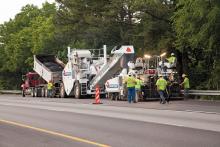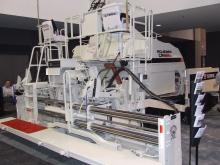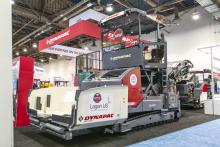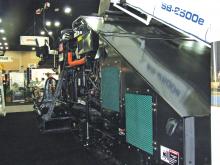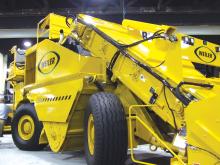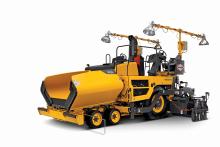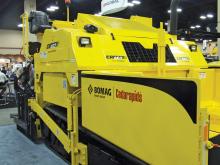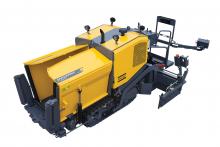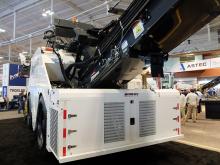Asphalt paving technology continues to develop, benefiting from new technologies and new diesel engines - Mike Woof reports The asphalt paving equipment market is seeing the introduction of new low emission engines that will meet the Tier 4 Final regulations for Europe and North America. These have required some major engineering changes, with firms now having to install bulky exhaust after-treatment systems and additional cooling for engines and turbos.
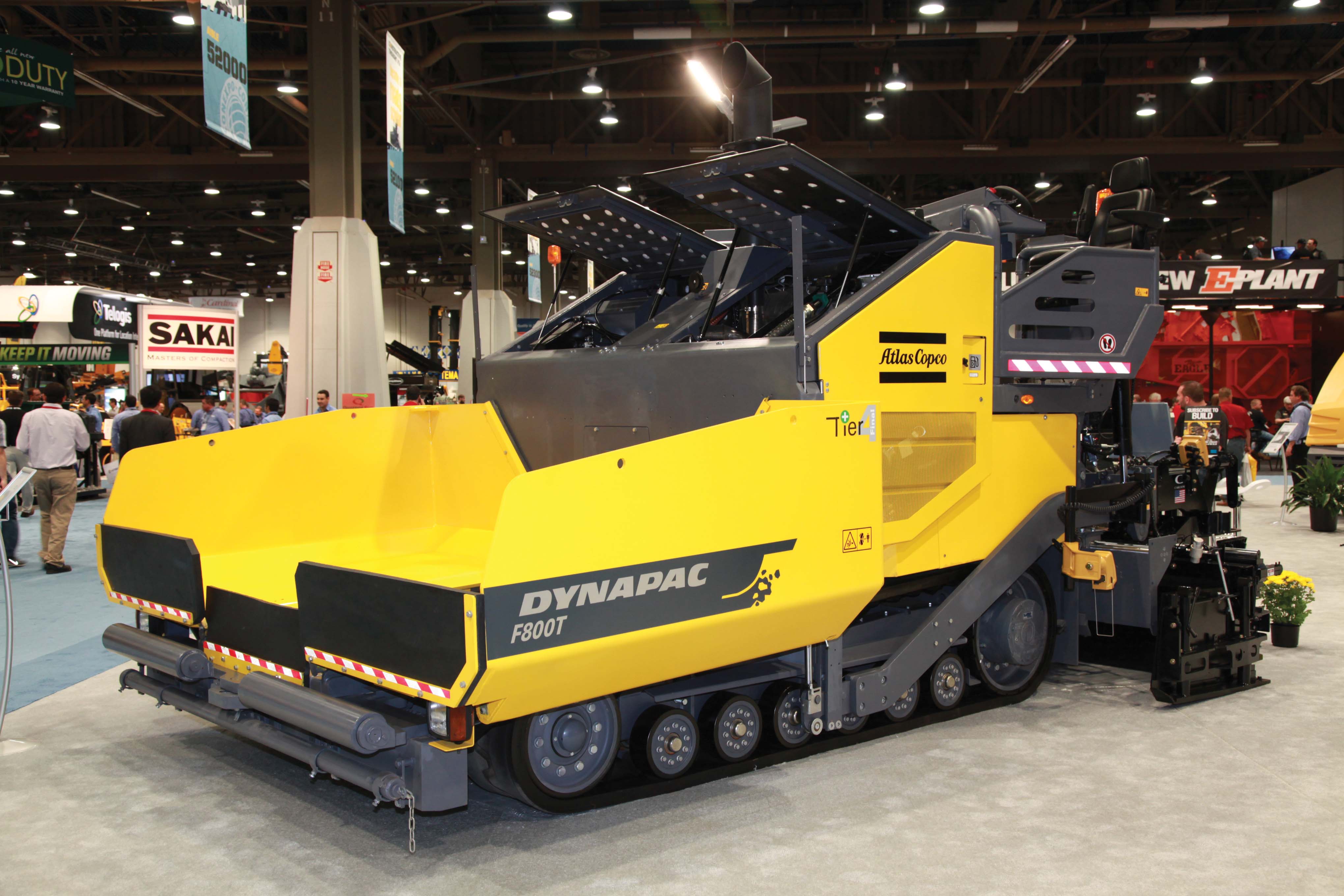
Dynapac’s new F800T paver is aimed at the US market and shares components with its sibling, the larger F1000T
Asphalt paving technology continues to develop, benefiting from new technologies and new diesel engines - Mike Woof reports
The asphalt paving equipment market is seeing the introduction of new low emission engines that will meet the Tier 4 Final regulations for Europe and North America. These have required some major engineering changes, with firms now having to install bulky exhaust after-treatment systems and additional cooling for engines and turbos.
The recent Conexpo 2014 event in Las Vegas was the launch venue for a number of new models, with a focus particularly on the high production type pavers used in the US market. These new machines are being introduced at a time when some reports suggest world demand for asphalt looks set to rise, so customers are expected to start buying new pavers to replace older units that have been retained while construction activity has been low. According to Cleveland-based market research company The2821 Freedonia Group, world demand for asphalt will grow by 3.6% annually until 2017.
This rise marks a notable change from the earlier decline in demand between 2007 and 2012 in North America and Western Europe, a result of the economic crisis. Over the period from 2012 to 2017, Freedonia expects to see a continuous annual growth rate of 3.6%. Much of this growth however looks set to be from China and other emergent markets.
Maintenance of North America’s massive regional network of roads and highways as well as in many parts of Western Europe will account for the majority of the road construction work in these developed markets.
The growth in road building in the Asia-Pacific region means it has overtaken North America as the world’s largest market for asphalt, driven mainly by China and India, according to Freedonia’s report ‘World Asphalt’.
China uses over 20% of the world’s asphalt, and is set to become the world’s biggest asphalt user. However, this trend will change when China’s national infrastructure programmes come to an end and the country moves to smaller road construction jobs and maintenance of its existing networks. Demand in India and other developing Asian countries will grow as they push on with large public works projects.
The machines now on offer are improved, with an array of capabilities available. Worldwide, the market focus is on pavers using European style tamper bar screeds and it is worth noting that the machines built by Chinese firms mainly use this type of technology. However, there is demand outside of North America also for the high production pavers with vibration type screeds offered to the US market, particularly in Latin America.
US firms specialise in units for this market but given the size of the North American and Latin American asphalt paver markets, several European manufacturers have developed machines to meet demand. One of the latest comes from161 Atlas Copco Construction Equipment’s 206 Dynapac brand. The new F800T is a 2.44m class paver and is powered by a 196 Cummins QSB6.7 diesel rated at 127kW and which meets the Tier 4 Final emissions requirements. According to Dynapac, this is a productive and stable paver for its size class, while the hydraulic components are oversized and use many of same parts as seen in the firm’s larger F1000 paver, which is said to ensure reliability and longevity. The use of common parts will also help cut spares holding costs for fleet customers. The machine features a high performance undercarriage system, which the firm claims allows the paver to push a truck even when the hopper is fully loaded. The machine is offered with the proven Carlson EZ08-15 front mounted screed, which features electric heating as standard and is widely used by several paver manufacturers competing in the North American market. The paver has been designed with a material transport system featuring oversized components and this is said to helps reduce materials segregation in the mat. Power for the screed’s electrical heating is provided by a large, hydraulically-driven generator that delivers 34kV, leaving plenty of capacity for powering additional equipment such as lighting for night-time working.
Meanwhile an important launch for1194 Vögele at Conexpo was of its improved Vision 5200-2i paver, which is designed for the North American market. The machine is equipped with the firm’s AB600TV screed, which allows it to pave widths from 3-8.5m. The Vision 5200-2i paver has been designed to meet the needs of US customers with its low deck design and high productivity, with power from the latest generation, low emission diesel that meets current regulations. This paver can also be used with sophisticated machine control technology to optimise operations, while it has been designed including a number of European paver style features also. In addition, the company has unveiled its latest European style Super 2100-3i paver in North America, although sales of this unit are likely to be limited for the time being at least in the US. The machine is equipped with the efficient AB600TP2 Plus screed with a tamper bar system and takes the place of the previous Super 2100-2.
A notable feature of the US asphalt paving market at present is the continued development of the material transfer vehicles (MTVs) used to supply pavers. And after many years of development, sales of these machines are also growing in markets outside of North America.
There is a good reason for the growth in demand for MTVs as using them allows continuous paving, which helps to improve the quality of the mat. When asphalt goes straight from a delivery truck to a paver’s hopper, the last asphalt quantity of asphalt leaving the hopper tends to be colder and is also most likely to suffer material segregation. This can result in (truck) bumps that do not compact properly and result in an uneven ride for road users, leaving areas that are also likely to fail earlier than the rest of the pavement. However using MTVs allows for a more homogeneous pavement and can address both the issues of material cooling and segregation. The machines keep the mix heated and agitated, addressing problems caused by asphalt segregating during the journey to site.
The need for MTVs on large highway construction jobs has been recognised by several road authorities and this method of working is now written into the specifications for projects in a number of countries. A notable development for the MTV sector is that from January 1st 2015, the use of material feeders for construction projects on national highways with an asphalt surface area of greater than 18,000m² will become a standard requirement in tender documents in Germany. This was announced in a circular issued by the Federal Ministry of Transport, Building and Urban Development in late 2013. The MTV market looks set to grow and given the move by the German authorities, other European countries that do not already have such a requirement may well follow suit.
1252 Roadtec is keen to maintain its strong position in the MTV sector and its Shuttle Buggy has been undergoing continuous development over the years to hone its performance. The latest version, the SB2500e Shuttle Buggy, is powered by a new Tier 4 Interim Cummins diesel, rather than the 178 Caterpillar engines used previously. The engine change was made as Roadtec felt the Cummins diesel offered a Tier 4 emissions solution that better fitted the Shuttle Buggy’s needs. The upgraded Shuttle Buggy has a 22.7tonne storage capacity and now offers a truck unloading capacity of 907tonnes/hour and a paver loading capacity of 544tonnes/hour.
The firm has also made a number of other improvements to the machine to make it more efficient and durable. A key development is with its increased throughput, due to bigger slats are bigger and a redesign of auger system, which improves material handling and also helps extend component wear life and reduce maintenance downtime. Roadtec has also beefed up the wear plates inside the machine, tripling their strength by upgrading the steel used, which will make a notable increase in overall machine life, according to the firm. Other changes have been made to improve maintenance. The opening to the unloading conveyor can now open all the way across to make cleaning easier, while the transfer conveyor has fully opening doors beneath, again aiding cleaning.
Weiler’s E2850 MTV has been developed along similar lines and is also a wheel-mounted machine, with power from a CAT C9 diesel rated at 224kW. Weighing nearly 34tonnes the machine features four-wheel and optional rear wheel steering as well as a three-speed hydrostatic drive system with variable speeds, allowing it to keep pace with the paving train. It has an asphalt capacity of 22.5tonnes, although the customer can install a hopper insert that increases capacity by an additional 5tonnes. The E2850 features hydraulically-operated clean-out doors on the dump hopper, storage hopper and rear conveyor to make the clean out process easier. The machine has high torque, direct drive motors with loop flush cooling system on its two conveyors and elevator, helping to reduce heat build-up within the hydraulic system during operation. The machine is also equipped with an innovative fumes extraction system that is designed to be folded away when the machine passes underneath an overhead obstruction. Interestingly, the Weiler 2850 is sold and serviced through the Caterpillar dealer network in the North American market and the firm has now also achieved a number of sales outside of the US.
Also built in the US is the CR662RM RoadMix machine now being manufactured by172 Bomag (one of several designs from Terex), which is designed to be used both as an MTV and paver. The machine can be switched quickly from paver to MTV use by removing the screed and fitting the conveyor system. The conveyor can swivel 55° to the left or right as well as featuring a variable-pitch in-hopper auger design that is said to provide high material throughput. This machine varies considerably from the Roadtec and Weiler machines as it runs on tracks rather than wheels.
The Vögele MT3000-2i Power Feeder also runs on tracks and is the firm’s latest development for this machine category, having evolved from the earlier MT1000. This new model also benefits from a low emission Tier 4 compliant diesel and suits use on large highway paving jobs. The improved MT 3000-2i features an offset capability due to its pivoting conveyor, which is said to increase utilisation as it allows the MTV to be used on sites with space restrictions where the paver has to be fed with mix from the side, as well as for backfilling crash barriers on highways or trenches. The firm has said that this machine can empty a 25tonne capacity lorry to be emptied in 60 seconds flat. Despite its throughput capability however the MT 3000-2i is said to be economical to run as well as featuring comparatively compact transport dimensions. The Vögele MTV is particularly well-suited to use with the firm’s giant Super 3000-2 paver, with its maximum 16m screed width and 1,600tonnes/hour throughput. The size of the paver and the enormous asphalt capacity it offers means that it would be difficult to use efficiently without an MTV to feed material.
Meanwhile the new tracked Dynapac MTV has been developed to a slightly different brief, offering high throughput but on a more compact chassis. The design of the Dynapac Mobile Feeder MF2500CS reveals a strong asphalt paver influence. However the company says that although it uses a lot of paver components in its construction, this is an all-new machine with a compact design and is now the only 2.55m-wide material transfer vehicle (MTV) in the market. The company has developed the machine to meet a need for a more compact MTV that is easier to transport than rival models and yet still able to provide high materials throughput for highway paving work. The company claims that its MF2500CS is cost effective to transport, with no permissions or special transport vehicles required. Although compact, the MF2500CS can empty a 27tonne truck in 35 seconds, giving a throughput of 4,000tonnes/hour.
The standard version of the MF2500CS features a short conveyor, but customers have the option of adding a conveyor that can swing out to either side behind the short belt. This allows the machine to supply two pavers at once if required, or to work alongside a paver. The machine is driven by a Stage IIIB/Tier4 Interim compliant Cummins QSB6.7 diesel, which is rated at 170kW. This has a thermostatic fan control that provides efficient cooling as well as sophisticated hydraulics to help optimise fuel efficiency.
Slurry innovation
360 VSS Macropaver is introducing an improved version of its successful slurry surfacing equipment, as well as upgraded variants of the mobile Minimac and skid-mounted emulsion plants. The upgrades to the slurry surfacing machine will increase its performance as well as its ability to handle tough road repair jobs and the unit now features a system for fibre feeding. The firm’s sister company is a contractor and has been using fibres extensively in slurry surfacing applications, allowing repairs on roads that would not otherwise be suitable for slurry technology by improving the road structure. The machine’s reporting capabilities have also been upgraded with new hardware, software and data collection systems, providing contractors with more information about the jobs being handled for later analysis and reference.
Upgrades to the micro-surfacing box allow it to offer a width range from 2.44-4.27m, an extra 300mm over competing machines, while the equipment is also easier to clean and other improvements make the machine easier to operate.
Clean paving
Bomag is unveiling its new 19tonne class wheeled paver, the BF 600 P-2, at Hillhead 2014. This machine offers a maximum output of 600 tonnes/hour and a maximum paving width of 8m and features the firm’s new S500 screed. Power comes from a2796 Mercedes MTU diesel that delivers 116kW and meets the Tier 4 Final emissions requirements. Fuel consumption is said to be low due to the integrated Ecomode engine-management system, which matches power to demand. Addiotnal fuel savings come from the hydraulically powered radiator fan, which only operates as required.
The high-performance S500 screed features a high-power Magmalife heating system, which is said to lower operating costs and increase safety. The screed features aluminium components that maximise heat conductivity and offers a short heat-up time of only 20–30 minutes, depending on screed width and ambient temperature, a time saving of 25% compared to earlier generation machines. The aluminium plates also provide effective heat distribution across the full smoothing plate, even with extensions fitted. The BF 600 P-2 also has a large-diameter auger that ensures even material distribution, even at wide paving widths, avoiding segregation and improving output.
To improve material transfer from truck to paver, the machine has adjustable bumper rollers which allow shock-free docking. An operator option is to control the bumper roller response manually and these units can be adjusted to match different truck dimensions, while the shock absorbers and integrated rocker ensure smooth material transfer.
The operator platform on the BF 600 P-2 has the Seat and operating console as a single unit that can be extended sideways for a maximum overhang of 600mm, ensuring the operator has the best view of the mat edges, the hopper, the auger, and the screed.
The asphalt paving equipment market is seeing the introduction of new low emission engines that will meet the Tier 4 Final regulations for Europe and North America. These have required some major engineering changes, with firms now having to install bulky exhaust after-treatment systems and additional cooling for engines and turbos.
The recent Conexpo 2014 event in Las Vegas was the launch venue for a number of new models, with a focus particularly on the high production type pavers used in the US market. These new machines are being introduced at a time when some reports suggest world demand for asphalt looks set to rise, so customers are expected to start buying new pavers to replace older units that have been retained while construction activity has been low. According to Cleveland-based market research company The
This rise marks a notable change from the earlier decline in demand between 2007 and 2012 in North America and Western Europe, a result of the economic crisis. Over the period from 2012 to 2017, Freedonia expects to see a continuous annual growth rate of 3.6%. Much of this growth however looks set to be from China and other emergent markets.
Maintenance of North America’s massive regional network of roads and highways as well as in many parts of Western Europe will account for the majority of the road construction work in these developed markets.
The growth in road building in the Asia-Pacific region means it has overtaken North America as the world’s largest market for asphalt, driven mainly by China and India, according to Freedonia’s report ‘World Asphalt’.
China uses over 20% of the world’s asphalt, and is set to become the world’s biggest asphalt user. However, this trend will change when China’s national infrastructure programmes come to an end and the country moves to smaller road construction jobs and maintenance of its existing networks. Demand in India and other developing Asian countries will grow as they push on with large public works projects.
The machines now on offer are improved, with an array of capabilities available. Worldwide, the market focus is on pavers using European style tamper bar screeds and it is worth noting that the machines built by Chinese firms mainly use this type of technology. However, there is demand outside of North America also for the high production pavers with vibration type screeds offered to the US market, particularly in Latin America.
US firms specialise in units for this market but given the size of the North American and Latin American asphalt paver markets, several European manufacturers have developed machines to meet demand. One of the latest comes from
Meanwhile an important launch for
A notable feature of the US asphalt paving market at present is the continued development of the material transfer vehicles (MTVs) used to supply pavers. And after many years of development, sales of these machines are also growing in markets outside of North America.
There is a good reason for the growth in demand for MTVs as using them allows continuous paving, which helps to improve the quality of the mat. When asphalt goes straight from a delivery truck to a paver’s hopper, the last asphalt quantity of asphalt leaving the hopper tends to be colder and is also most likely to suffer material segregation. This can result in (truck) bumps that do not compact properly and result in an uneven ride for road users, leaving areas that are also likely to fail earlier than the rest of the pavement. However using MTVs allows for a more homogeneous pavement and can address both the issues of material cooling and segregation. The machines keep the mix heated and agitated, addressing problems caused by asphalt segregating during the journey to site.
The need for MTVs on large highway construction jobs has been recognised by several road authorities and this method of working is now written into the specifications for projects in a number of countries. A notable development for the MTV sector is that from January 1st 2015, the use of material feeders for construction projects on national highways with an asphalt surface area of greater than 18,000m² will become a standard requirement in tender documents in Germany. This was announced in a circular issued by the Federal Ministry of Transport, Building and Urban Development in late 2013. The MTV market looks set to grow and given the move by the German authorities, other European countries that do not already have such a requirement may well follow suit.
The firm has also made a number of other improvements to the machine to make it more efficient and durable. A key development is with its increased throughput, due to bigger slats are bigger and a redesign of auger system, which improves material handling and also helps extend component wear life and reduce maintenance downtime. Roadtec has also beefed up the wear plates inside the machine, tripling their strength by upgrading the steel used, which will make a notable increase in overall machine life, according to the firm. Other changes have been made to improve maintenance. The opening to the unloading conveyor can now open all the way across to make cleaning easier, while the transfer conveyor has fully opening doors beneath, again aiding cleaning.
Weiler’s E2850 MTV has been developed along similar lines and is also a wheel-mounted machine, with power from a CAT C9 diesel rated at 224kW. Weighing nearly 34tonnes the machine features four-wheel and optional rear wheel steering as well as a three-speed hydrostatic drive system with variable speeds, allowing it to keep pace with the paving train. It has an asphalt capacity of 22.5tonnes, although the customer can install a hopper insert that increases capacity by an additional 5tonnes. The E2850 features hydraulically-operated clean-out doors on the dump hopper, storage hopper and rear conveyor to make the clean out process easier. The machine has high torque, direct drive motors with loop flush cooling system on its two conveyors and elevator, helping to reduce heat build-up within the hydraulic system during operation. The machine is also equipped with an innovative fumes extraction system that is designed to be folded away when the machine passes underneath an overhead obstruction. Interestingly, the Weiler 2850 is sold and serviced through the Caterpillar dealer network in the North American market and the firm has now also achieved a number of sales outside of the US.
Also built in the US is the CR662RM RoadMix machine now being manufactured by
The Vögele MT3000-2i Power Feeder also runs on tracks and is the firm’s latest development for this machine category, having evolved from the earlier MT1000. This new model also benefits from a low emission Tier 4 compliant diesel and suits use on large highway paving jobs. The improved MT 3000-2i features an offset capability due to its pivoting conveyor, which is said to increase utilisation as it allows the MTV to be used on sites with space restrictions where the paver has to be fed with mix from the side, as well as for backfilling crash barriers on highways or trenches. The firm has said that this machine can empty a 25tonne capacity lorry to be emptied in 60 seconds flat. Despite its throughput capability however the MT 3000-2i is said to be economical to run as well as featuring comparatively compact transport dimensions. The Vögele MTV is particularly well-suited to use with the firm’s giant Super 3000-2 paver, with its maximum 16m screed width and 1,600tonnes/hour throughput. The size of the paver and the enormous asphalt capacity it offers means that it would be difficult to use efficiently without an MTV to feed material.
Meanwhile the new tracked Dynapac MTV has been developed to a slightly different brief, offering high throughput but on a more compact chassis. The design of the Dynapac Mobile Feeder MF2500CS reveals a strong asphalt paver influence. However the company says that although it uses a lot of paver components in its construction, this is an all-new machine with a compact design and is now the only 2.55m-wide material transfer vehicle (MTV) in the market. The company has developed the machine to meet a need for a more compact MTV that is easier to transport than rival models and yet still able to provide high materials throughput for highway paving work. The company claims that its MF2500CS is cost effective to transport, with no permissions or special transport vehicles required. Although compact, the MF2500CS can empty a 27tonne truck in 35 seconds, giving a throughput of 4,000tonnes/hour.
The standard version of the MF2500CS features a short conveyor, but customers have the option of adding a conveyor that can swing out to either side behind the short belt. This allows the machine to supply two pavers at once if required, or to work alongside a paver. The machine is driven by a Stage IIIB/Tier4 Interim compliant Cummins QSB6.7 diesel, which is rated at 170kW. This has a thermostatic fan control that provides efficient cooling as well as sophisticated hydraulics to help optimise fuel efficiency.
Slurry innovation
Upgrades to the micro-surfacing box allow it to offer a width range from 2.44-4.27m, an extra 300mm over competing machines, while the equipment is also easier to clean and other improvements make the machine easier to operate.
Clean paving
Bomag is unveiling its new 19tonne class wheeled paver, the BF 600 P-2, at Hillhead 2014. This machine offers a maximum output of 600 tonnes/hour and a maximum paving width of 8m and features the firm’s new S500 screed. Power comes from a
The high-performance S500 screed features a high-power Magmalife heating system, which is said to lower operating costs and increase safety. The screed features aluminium components that maximise heat conductivity and offers a short heat-up time of only 20–30 minutes, depending on screed width and ambient temperature, a time saving of 25% compared to earlier generation machines. The aluminium plates also provide effective heat distribution across the full smoothing plate, even with extensions fitted. The BF 600 P-2 also has a large-diameter auger that ensures even material distribution, even at wide paving widths, avoiding segregation and improving output.
To improve material transfer from truck to paver, the machine has adjustable bumper rollers which allow shock-free docking. An operator option is to control the bumper roller response manually and these units can be adjusted to match different truck dimensions, while the shock absorbers and integrated rocker ensure smooth material transfer.
The operator platform on the BF 600 P-2 has the Seat and operating console as a single unit that can be extended sideways for a maximum overhang of 600mm, ensuring the operator has the best view of the mat edges, the hopper, the auger, and the screed.

